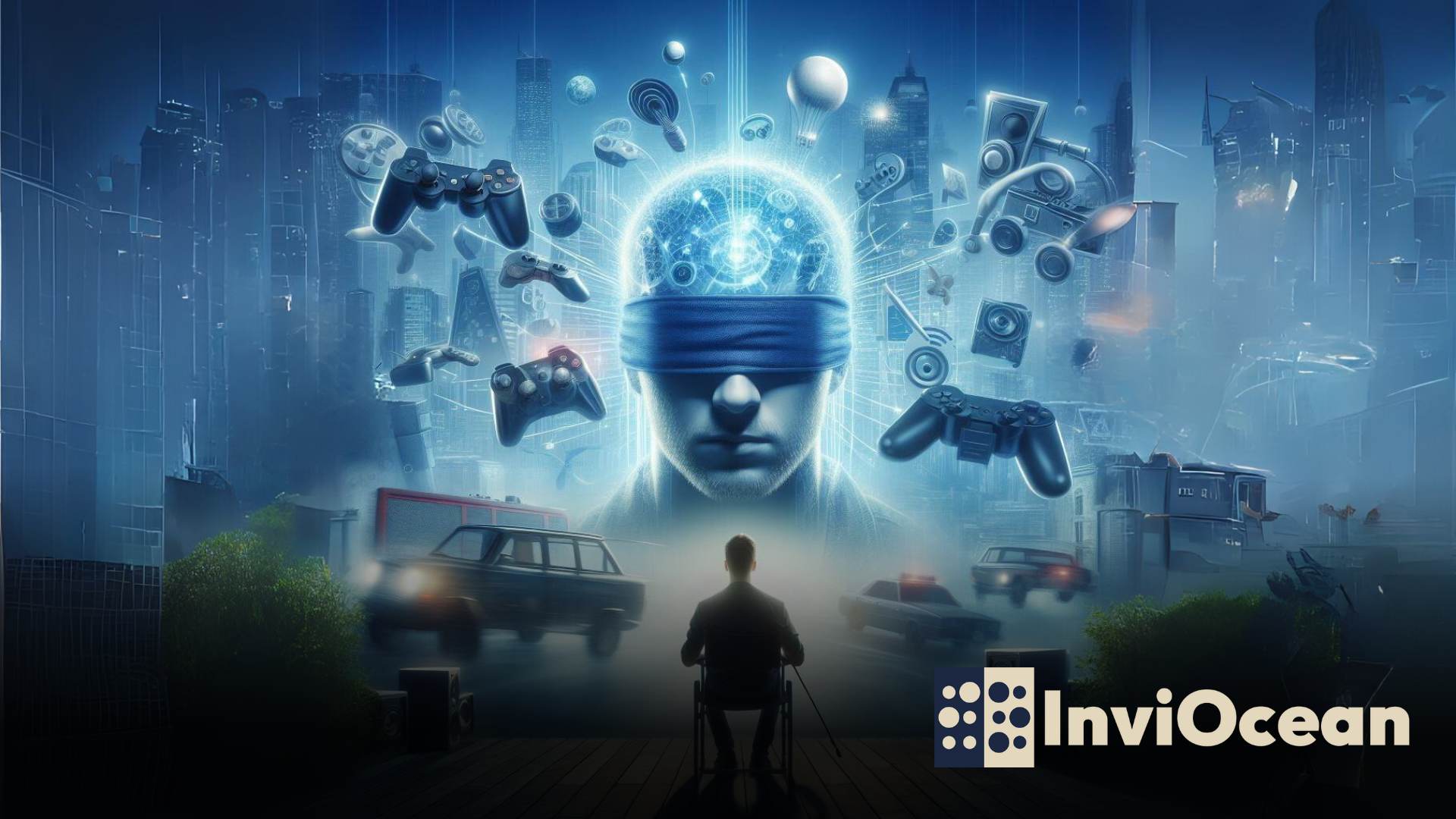Can Blind People Play Video Games?
You might wonder, “Can blind people play video games?” It sounds like a tough question because we usually think of video games as something you need to see to enjoy. But the good news is that thanks to new technology and people in the gaming world who really care about including everyone, blind and visually impaired players can now enjoy video games too. In this article, we’ll look at the cool tools and changes that are making video games something everyone can play. We’ll talk about games that you can play using sound, special controllers that let you feel the game, and how players and game makers are working together to make gaming fun for everyone. Let’s find out how blind people are getting in on the gaming action and having a great time doing it.
Blind Gamers Challenges

Blind players face several significant challenges when interacting with traditional video games, primarily because most games are designed with visual feedback as a central element. Here are some of the key challenges:
- Visual Dependence: The majority of video games rely heavily on visual cues for gameplay, narrative progression, and player feedback. This includes everything from navigating environments to identifying enemies, reading game menus, and understanding game mechanics. Blind players may find it impossible to engage with these elements.
- Lack of Accessibility Features: Many games do not include features that make them accessible to blind players, such as audio descriptions, screen reader compatibility, or haptic feedback that can convey information without sight.
- Complex User Interfaces: Video games often have complex user interfaces that include multiple menus, sub-menus, and on-screen indicators. Navigating these interfaces without visual cues can be extremely challenging for blind players.
- Spatial Navigation: Games that require spatial navigation and orientation in a 3D or even 2D space can be particularly difficult for blind players to manage, as visual cues are typically used to orient and navigate through game environments.
- Quick-Time Events: Many games incorporate quick-time events or require fast reactions to visual stimuli. These elements are often inaccessible to blind players, as they require immediate visual processing and response.
- Lack of Audio Cues: While some games may include sound effects and music, they often lack the necessary detailed audio cues that blind players would need to fully understand and interact with the game environment, characters, and story.
- Social Exclusion: Multiplayer and competitive gaming environments can be particularly exclusionary, as blind players may not be able to participate on an equal footing due to the visual nature of these games, leading to social exclusion within gaming communities.
- Limited Game Selection: There are fewer games designed with accessibility for the blind in mind, which severely limits the selection of games available for blind players to enjoy.
Accessibility in Gaming
Making games accessible is an important part of creating video games. It means designing games so that everyone can play and enjoy them, including people with different abilities and disabilities. This idea is not just about letting players start a game. It’s about building a gaming world where everyone can join in and have fun, no matter their physical or mental challenges. Making games accessible helps include everyone, making sure the gaming world is friendly and open to all.
Breaking Down Barriers
In video games, players might face obstacles like complicated controls, needing to see or hear well, or menus that are hard to use for those with movement or thinking difficulties. Features that make games more accessible remove these obstacles. These features could be controls that players can change to suit their needs, options to have game text read out loud, sound hints to replace things you need to see, and ways to change the game’s difficulty. This makes it easier for everyone to play games.
Building a Community for Everyone
Video games are great at bringing people together. They create groups where players can share fun times, tips, and friendships. When games are accessible, these groups welcome everyone, no matter their background or disabilities. This makes the gaming community richer and shows that video games are for everyone to enjoy together.
Reflecting Real-World Diversity
The world is full of different people, including those with disabilities. When game makers include features that make games easier to access, they make games that show the world’s diversity. This helps everyone understand more about disabilities, helps players who don’t have disabilities to understand others better, and gives players with disabilities games that feel more relevant to their lives.
Legal and Ethical Considerations
Making games accessible is the right thing to do, and in many places, it’s also the law. Countries have rules that say digital things, like video games, must be easy for everyone to use. When game developers follow these rules, they avoid legal problems and show they’re committed to treating all players fairly.
Enhancing Game Accessibility for Vision Impaired Players

There are many ways to make video games easier for players with vision impairments to play. Some of these methods come from the players themselves, while others are the work of the people who make the games.
- Developer-Led Accessibility. The best situation is when the people making the game decide to add features for players with vision impairments from the very start. Doing this makes sure that these features are a basic part of the game, which can make the game much easier to play for those who have trouble seeing. Starting with accessibility in mind can open up many more possibilities than trying to add these features later.
- Retrofitting Accessibility. Retrofitting refers to the addition of accessibility features after a game has already been launched. This isn’t the best way to implement features, but it has helped make games like “Gears 5,” “Sea of Thieves,” “Killer Instinct,” and “God of War” easier for players with vision impairments to enjoy. These updates after the game’s release have let more people play and enjoy these games.
- Community-Driven Mods. Mods are changes that players make to games to add new features, and some of these mods make games more accessible. These mods can do things like make the game work with screen reading software, make the visuals easier to see, add new sounds to help players understand what’s happening in the game, or even change how the game is played. Mods like “Say The Spire,” “Hearthstone Access,” and “Hades Accessibility Mods” have made some games much more playable for people with vision impairments. These mods show how dedicated players are to making games more inclusive.
While direct developer implementation of accessibility features is the gold standard, the gaming community has shown resilience and creativity in making games more accessible through retrofitting and mods. Each of these approaches plays a crucial role in ensuring that gaming remains an inclusive and accessible form of entertainment for all, regardless of visual ability.
Technologies for Blind Gaming
New technology has been key in making video games easier for blind players to play. Tools like screen readers, haptic feedback, and sound-based controls have changed gaming for people who can’t see. These technologies offer new ways for players to get game information, interact with the game, and enjoy the story and action without needing to see the screen.
- Screen Readers. Screen readers are software applications that convert text displayed on the screen into speech or Braille output, allowing blind or visually impaired users to read and navigate their devices. In the context of gaming, screen readers can help blind players access menus, read in-game text, and interact with user interfaces that would otherwise be inaccessible. For games that are heavily text-based or include complex menus and interfaces, screen readers are indispensable for providing a level playing field.
- Haptic Feedback. Haptic feedback technology uses touch to communicate with users, providing tactile responses to in-game actions. This can range from simple vibrations to more sophisticated force feedback mechanisms that simulate physical experiences. For blind players, haptic feedback can convey a wide array of game information, such as indicating the direction of incoming attacks, the texture of different terrains, or the confirmation of successful actions. This sensory feedback helps create a more immersive and intuitive gaming experience, allowing players to “feel” their way through the game.
- Audio-Based Interfaces. Audio-based interfaces and games rely primarily on sound to convey information and provide interactive experiences. These can include spoken instructions, ambient soundscapes, directional audio cues, and intricate sound effects that help players navigate and understand the game environment. Audio games, designed specifically with blind players in mind, often use binaural audio techniques to create a three-dimensional soundscape, allowing players to accurately discern the position and movement of objects and characters in the game world.
Games Designed for Blind Players

Several games have been developed with the needs of blind players at the forefront, utilizing these technologies to provide rich, accessible gaming experiences:
- “The Vale: Shadow of the Crown”: This audio-based adventure game uses binaural audio and voice acting to create an immersive experience that relies entirely on sound. Players navigate through a medieval world, engage in combat, and interact with characters using audio cues alone, making it fully accessible to blind and visually impaired players.
- “A Blind Legend”: Another example of an audio game, “A Blind Legend” is an action-adventure game where players control a blind knight, guided by the voice of his daughter. The game uses stereo sound to help players navigate through various challenges and combat scenarios, relying on auditory cues to make decisions and progress through the story.
Several AAA titles have made significant strides in accessibility for blind and visually impaired players. Here are a few notable examples:
- The Last of Us Part II – This game has been widely praised for its extensive accessibility features. It includes over 60 accessibility settings, with options specifically designed for visually impaired and blind players, such as detailed audio descriptions, enhanced listening mode, and navigation and traversal assistance.
- God of War Ragnarök – Following in the footsteps of its predecessor, this game offers various accessibility options, including settings that assist blind and low vision players. While specific details on features for blind players are less common, the game has been recognized for its commitment to inclusivity.
- Forza Horizon 5 – This racing game is noted for its inclusive design, offering features like customizable controls and difficulty settings that can help accommodate blind players. The game also utilizes sound cues and haptic feedback to enhance the experience for those relying on audio and touch.
- Marvel’s Spider-Man – Insomniac Games included various accessibility features in their Spider-Man series, such as customizable controls and visual aids. While these features are primarily aimed at players with low vision, they demonstrate a move towards more inclusive game design.
The New Era of Accessible Gaming for the Blind
In conclusion, the answer to whether blind people can play video games is a resounding “Yes.” The journey through the evolving landscape of accessible gaming has shown us that with innovation, inclusion, and community support, video games can transcend traditional barriers. Tools like audio interfaces, haptic feedback, and screen readers, along with the creative efforts of developers and the gaming community, have opened up new worlds of possibility. These advancements not only empower blind and visually impaired individuals to engage with video games but also enrich the gaming community by embracing diversity. As we look to the future, it’s clear that the commitment to making gaming accessible for all is not just changing the way we play games; it’s changing the way we think about the possibilities of gaming itself.
